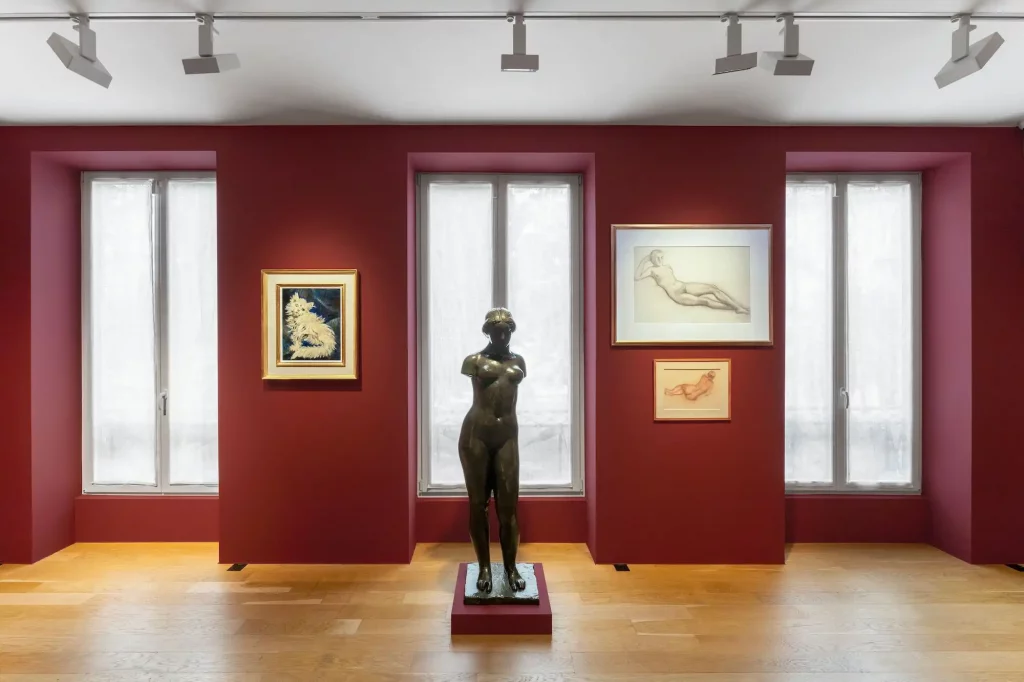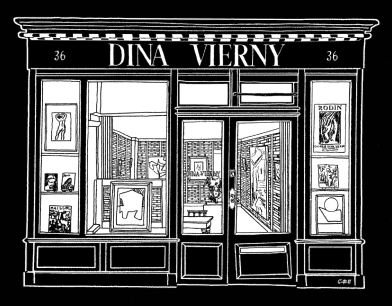All Exhibitions here
The exhibition "Dans la tête de Balthus" at Perrotin Matignon 8 was curated by Edwart Vignot and Isotta Bosi. The event offers a glimpse into the creative processes of Balthus, a major painter of the 20th century.July 27, 2023
 View of the exhibition "Dans la tête de Balthus" at Perrotin Matignon 8, Photo Nicolas Brasseur. ©ADAGP 2023. Courtesy of all the artists and Perrotin.
View of the exhibition "Dans la tête de Balthus" at Perrotin Matignon 8, Photo Nicolas Brasseur. ©ADAGP 2023. Courtesy of all the artists and Perrotin. The dialogues highlight his many sources of inspiration through various elements, such as film archives dating from 1993, works by 19th-century artists who were Balthus's masters, and works by his contemporaries, some of whom were his close friends.


View of the exhibition "Dans la tête de Balthus" at Perrotin Matignon 8, Photo Nicolas Brasseur. ©ADAGP 2023. Courtesy of all the artists and Perrotin.
Among his sources of inspiration is Aristide Maillol. On the first floor of the gallery, we discover three works by the master, including the sculpture "Harmonie (1er état)", created in 1940 with the young Dina Vierny. It is accompanied by two drawings, the mysterious "Jeune fille allongée" and the "Nu féminin couché de dos (Dina)".

Balthus, "Étude Pour La Cuisine De Chassy", 1955, Soft pencil on paper, 35 × 26.6 cm. Courtesy of all the artists and Perrotin.

Aristide Maillol, "Jeune fille allongée", undated, Charcoal and stump on Montval paper, 50 x 76 cm. Courtesy of all the artists and Perrotin.
A parallel can be drawn between the treatment of the female body by the two artists, who both used young women as models at some point in their careers. While Maillol transformed the bodies of his models into universal, timeless volumes and ideas with a kind of seductive, detached gentleness, Balthus turned the bodies of his young models into objects of fascination and seduction, playing with the boundaries between adolescence and adulthood. Maillol was therefore more interested in the beauty and harmony of form, while Balthus was more interested in the ambiguity and suggestive atmosphere of his compositions.

Laurent Grasso, "Studies into the Past", Oil and palladium leaf on wood, 22.5 × 24.5 × 5.5 cm. Courtesy of all the artists and Perrotin.
The works of Maillol and Balthus are surrounded by works by artists such as Francis Picabia, André Derain, Alberto Giacometti and Gustave Courbet, all dealing with the human and animal figure. The exhibition also aims to demonstrate the enduring influence of Balthus on the art scene, even today. It therefore offers a glimpse of the links between past and present, highlighting Balthus's enduring legacy and impact on the art scene. Six contemporary artists have been invited by Galerie Perrotin to create works inspired by Balthus.
Among his sources of inspiration is Aristide Maillol. On the first floor of the gallery, we discover three works by the master, including the sculpture "Harmonie (1er état)", created in 1940 with the young Dina Vierny. It is accompanied by two drawings, the mysterious "Jeune fille allongée" and the "Nu féminin couché de dos (Dina)".
 View of the exhibition "Dans la tête de Balthus" at Perrotin Matignon 8, Photo Nicolas Brasseur. ©ADAGP 2023. Courtesy of all the artists and Perrotin.
View of the exhibition "Dans la tête de Balthus" at Perrotin Matignon 8, Photo Nicolas Brasseur. ©ADAGP 2023. Courtesy of all the artists and Perrotin. The exhibition "Dans la tête de Balthus" at Perrotin Matignon 8 was curated by Edwart Vignot and Isotta Bosi. The event offers a glimpse into the creative processes of Balthus, a major painter of the 20th century.
The dialogues highlight his many sources of inspiration through various elements, such as film archives dating from 1993, works by 19th-century artists who were Balthus's masters, and works by his contemporaries, some of whom were his close friends.
Among his sources of inspiration is Aristide Maillol. On the first floor of the gallery, we discover three works by the master, including the sculpture "Harmonie (1er état)", created in 1940 with the young Dina Vierny. It is accompanied by two drawings, the mysterious "Jeune fille allongée" and the "Nu féminin couché de dos (Dina)".

Balthus, "Étude Pour La Cuisine De Chassy", 1955, Soft pencil on paper, 35 × 26.6 cm. Courtesy of all the artists and Perrotin.

Aristide Maillol, "Jeune fille allongée", undated, Charcoal and stump on Montval paper, 50 x 76 cm. Courtesy of all the artists and Perrotin.
A parallel can be drawn between the treatment of the female body by the two artists, who both used young women as models at some point in their careers. While Maillol transformed the bodies of his models into universal, timeless volumes and ideas with a kind of seductive, detached gentleness, Balthus turned the bodies of his young models into objects of fascination and seduction, playing with the boundaries between adolescence and adulthood. Maillol was therefore more interested in the beauty and harmony of form, while Balthus was more interested in the ambiguity and suggestive atmosphere of his compositions.

Laurent Grasso, "Studies into the Past", Oil and palladium leaf on wood, 22.5 × 24.5 × 5.5 cm. Courtesy of all the artists and Perrotin.
The works of Maillol and Balthus are surrounded by works by artists such as Francis Picabia, André Derain, Alberto Giacometti and Gustave Courbet, all dealing with the human and animal figure. The exhibition also aims to demonstrate the enduring influence of Balthus on the art scene, even today. It therefore offers a glimpse of the links between past and present, highlighting Balthus's enduring legacy and impact on the art scene. Six contemporary artists have been invited by Galerie Perrotin to create works inspired by Balthus.
